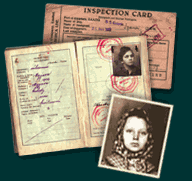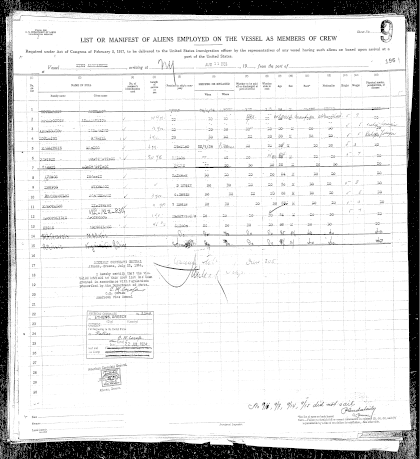IMMIGRANT PASSENGER SHIP RECORDS NOW ONLINE: GUIDE TO RETRIEVING RECORDS FROM THE ELLIS ISLAND FOUNDATION DATABASE
By Mary Papoutsy
Founder of Hellenic Historical and Genealogical Association
The increasing globalization of business practices, due in large part to the advent of new technologies like the Internet, has helped to build cyberbridges in many areas of our society. Genealogy, or the study of ones' family tree and ancestral roots, is no exception to this technological revolution. The availability of portable scanners, powerful laptop and desktop computers, and an explosion of new software programs, online databases and how-to sites have thrust genealogy into the forefront of nascent, cutting-edge social sciences. No longer limited solely to the development of one's personal family tree, the field of genealogy has become a fully fledged science in its own right. Genealogists now work alongside criminologists, medical geneticists, and historians, applying their techniques to an ever-widening scope of investigations.
As new technologies become available, genealogists have worked quickly to implement them in their searches. And one of the greatest projects ever undertaken by volunteer genealogists, the computerization of Ellis Island passenger arrival records, has been made possible by advances in the computer world. Its significance cannot be underestimated for Greek-Americans, for the largest majority of Greek immigrants came through Ellis Island. Therefore, nearly every American family of Hellenic descent can benefit from using this new online database.
One of the primary goals of any family history search is to locate records of one's immigrant ancestor, that person who first settled in the U.S. Typically, this means locating passenger arrival records, since these can provide a wealth of information about the ancestor at the time of immigration. As an added bonus, researchers often find on the ship manifests the names of other relatives accompanying the ancestor, since immigrants often traveled in groups from the same village or town.
Until now, these records were generally found in two places, at a regional archive of the National Archives and Records Administration, and at the Family History Centers of the Church of Latter Day Saints of Jesus Christ (Mormons). Everything was stored on microfilms. To find the original page of the ship manifest meant that one first had to examine indexes on microfilm to locate the name of one's ancestor and the number of the microfilm roll containing the full entry, then to send for the microfilm roll with the actual manifest records. It was generally a rather time-consuming procedure, requiring patience and diligence, especially if the records of one's ancestor fell in a year that was NOT INDEXED at all and one had to search through endless rolls of microfilm to find the entries.
But all that has changed with the availability of a new online database, one component of a multi-million-dollar American Family Immigration History Center at Ellis Island. More than 12,000 volunteers donated millions of hours over 4 years to transcribe and enter 22 million names into the database, approximately 60% of the nation's immigration records. According to officials, the project was the "culmination of a cooperative agreement between the National Park Service, the Statue of Liberty-Ellis Island Foundation, and the Church of Jesus Christ of Latter-Day Saints." Labeled the most difficult project of its type, the database also includes "U.S. citizens who were returning home, crew members, non-immigrant aliens, deportees, and those who literally missed the boat. The Port of New York accounted for 71% of all immigrant arrivals to the United States during the time period of 1892-1924.
Costing more than twenty-five million dollars, raised entirely from the private sector, this project is easily the most massive genealogical undertaking in the world. Imagine that during peak immigration waves nearly a century ago, more than one million immigrants passed through Ellis Island annually. In all, experts estimate that over 17 million immigrants arrived through this famous American gateway; perhaps 40% of the entire US population has at least one ancestor who was processed at Ellis Island.
The availability of this database, then, is a great boon to everyone, not just to Greek-Americans. It's simple, user-friendly and FREE. Researchers simply log into this database online in the convenience of their homes. Following the prompts, site visitors create an online User Name for themselves and a Password that they use on subsequent visits. Although the site receives many hits, visitors can still gain access even during daytime and normal business hours.
What Information the Database Yields
Along with information and photos of the ships themselves, researchers can expect to retrieve at least 11 pieces of information, or fields, from a computer search,: a full name (given and surname), ethnicity, last residence (town and country), date of arrival, age at arrival, gender, marital status, the name of the ship on which the ancestor traveled, and the port of embarkation. If one then opts to view the original ship manifest, then additional information can be gleaned from the forms completed by ship agents for US government officials. The amount of money possessed by the ancestor, his or her final destination, whether or not he or she had been to the US before, and the name and address -- and relationship -- of the person whom he would join in the United States, and a physical description may all also be decoded from the handwriting of the ship's agent. The data collected by ships' agents for the US government varied over time, but, generally speaking, the amount of information increased over the decades. To learn more details about the passenger ship records, consult with any one of the following excellent texts:
Colletta, John Philip. They Came in Ships. A Guide to Finding Your Immigrant Ancestor's Arrival Record. 1989. Revised edition. Salt Lake City, Utah: Ancestry, 1993.
Szucs, Lorretto Dennis. "Ship Passenger Arrival Lists." In They Became Americans. Finding Naturalization Records and Ethnic Origins, 74-82. Salt Lake City, Utah: Ancestry Incorporated, 1998.
"Passenger Arrival Lists," Chap. 2 in Guide to Genealogical Research in the National Archives. 1983. Revised edition. Washington, D.C.: National Archives Trust Fund Board for the National Archives and Records Administration, 1985.
Visits to Ellis Island Computer Center Expensive
Alternatively, persons can visit the computer center (American Family Immigration History Center) in person at the Ellis Island Museum. The software for locating records is the same, but there are a number of fees involved in reaching the museum complex and using the computers. First, visitors need to purchase a ferry ticket ($8 per adult), and then a small, bar-coded scan card that permits only 17 minutes of research at any one session ($5 fee each session -- an
"entrance fee"). Each scanned reproduction of an 11 x 22 original ship manifest page costs $25; for 17 x 22 reproductions, the fee is $35. Pictures of the ships themselves (photocopies) cost a hefty $12.50 apiece for the large size, $10 for the small ones. By the end of a one-half hour session -- assuming that one can work speedily -- one's final bill can easily reach $100.




